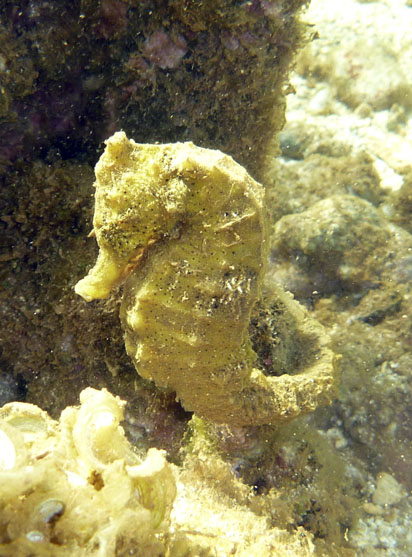Published in the Ocean Watch column, Honolulu Star-Advertiser © Susan Scott
November 18, 2013
Last year, after I wrote my second column about snorkeling with sea horses, I got an email with the subject “Stop writing about Hawaii’s seahorses!” The writer had also found a sea horse habitat and worried that if word got around about the locations of these rare fish, collectors would take them.
And, to my sorrow, some did. Since then, following the Waikiki Aquarium’s policy, I’ve kept my sea horse sightings to myself.
The problem with such secrecy is that researchers lack the information to study the beleaguered little fish. With little knowledge as to sea horse whereabouts, conservationists can’t make management programs. And we desperately need some.
 The common sea horse, Hippocampus kuda,
The common sea horse, Hippocampus kuda,
lives in the ocean near Hawaii.
©2013 Susan Scott
Each year, people worldwide sell 13 million sea horses, dead and alive, as traditional Chinese medicine, for aquarium pets and as curios and souvenirs. Yet on the International Union for the Conservation of Nature Red List of Threatened Species, only 11 of the world’s 48 sea horses are listed. It’s likely that far more are endangered, but biologists don’t have enough facts to assess their conservation status. Twenty-six sea horse species are labeled “Data Deficient.”
Now biologists from the University of British Columbia, the Zoological Society of London and Chicago’s Shedd Aquarium offer a smartphone app called iSeahorse which lets snorkelers and divers report their sea horse sightings.
The app knows where you are by your phone’s GPS signal. Press “Add an Observation” and the program places a pin on the app map. On the geoprivacy button, you choose “obscured,” which will place the pin off by six miles. The researchers know the exact coordinates, but other app users will not.
To add a sighting, you must pick the species from a list in the app called Seahorse Guide. For a definitive ID, take a picture. (Try not to alarm the sea horse. Pregnant males can have “miscarriages” if they feel threatened.)
In Hawaii if you see a large, 8-inch-long sea horse, it’s a common sea horse, Hippocampus kuda. Smaller at 3 inches, and less common, is Fisher’s sea horse, Hippocampus fisheri.
A third possibility is a species called the thorny sea horse, Hippocampus histrix, 6 inches long with obvious spines on the head and body. Only one individual has ever been found — off Maui in the 1920s — but with this new team of citizen and research scientists working together, I wouldn’t be surprised if we hear about a second.
With iSeahorse I’ll know about others’ sightings of these little charmers in Hawaii. I’ll also write about them.
Visit www.iseahorse.org.